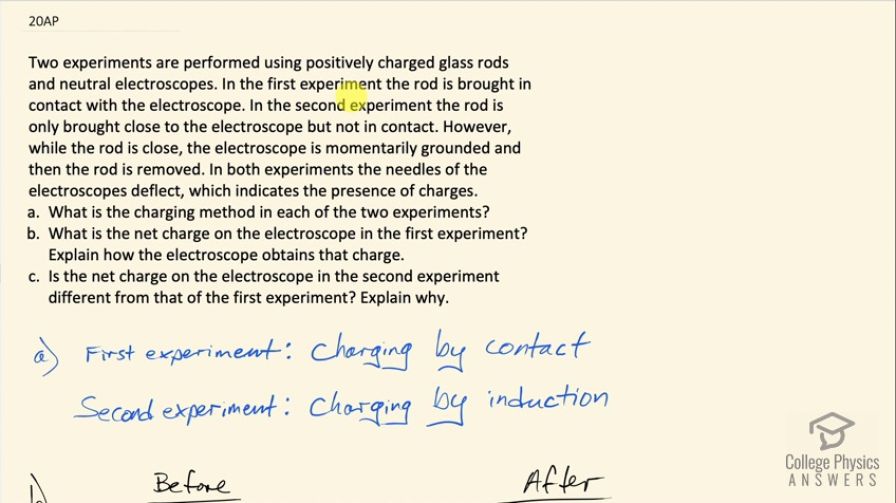Question
Two experiments are performed using positively charged glass rods and neutral electroscopes. In the first experiment the rod is brought in contact with the electroscope. In the second experiment the rod is only brought close to the electroscope but not in contact. However, while the rod is close, the electroscope is momentarily grounded and then the rod is removed. In both experiments the needles of the electroscopes deflect, which indicates the presence of charges.
- What is the charging method in each of the two experiments?
- What is the net charge on the electroscope in the first experiment? Explain how the electroscope obtains that charge.
- Is the net charge on the electroscope in the second experiment different from that of the first experiment? Explain why.
Final Answer
- First experiment: charging by contact. Second experiment: charging by induction.
- Positive due to the transfer of electrons to the rod.
- The net charge is not the same as in part (b). It is now negative due to the electrons accumulated from ground.
Solution video
OpenStax College Physics for AP® Courses, Chapter 18, Problem 20 (Test Prep for AP® Courses)

vote with a rating of
votes with an average rating of
.
Video Transcript
This is College Physics Answers with Shaun Dychko. Two experiments are performed using positively charged glass rods and neutral electroscopes. In the first experiment, a rod is brought in contact with the electroscope and in the second experiment, the rod is brought close but not in contact although while close, the electroscope is attached to ground and then the rod is removed afterwards. In both experiments, the needles of the electroscopes deflect which indicates the presence of charges so what is the charging method in each of the two experiments? Well, in part (a), we are gonna say that the first experiment is charging by contact and I have illustrated that here where before you have a positively charged glass rod and a neutral electroscope and the way I have drawn my electroscope is this is a metal ball with a metal rod here and at the end of it are two gold leaf pieces of gold foil and it's in a box that protects it from moisture because, you know, the polar molecules of water neutralize electrostatic charge so it's in a box to protect it from that and then after it's in contact, some of the charge from the glass rod will have attracted some electrons from the electroscope and have been neutralized. So the electroscope provided some electrons to neutralize some of the positive charge on the glass rod and the electroscope is therefore left positively charged as well since it lost some of the electrons. Okay so electrons have been transferred from the electroscope and that's why it is positively charged after. In the next experiment, we have to talk about the net charge and is it different from the first experiment? And here's some illustrations to explain why it is going to be different in this case, it's going to be negatively charged after the experiment is done whereas in the charging-by-contact, we had a net positive charge afterwards whereas in this charging-by-induction experiment, we are going to have a net negative charge. Okay! So before we have a positively charged glass rod and a neutral electroscope then the glass rod is brought close by and... (I suppose I should change these gold leaves down here by the way... this should indicate some charge is now on it) So anyway... yes, this rod is brought close and a charge distribution is induced so some of the electrons from the far side of this ball are attracted to the near side near the glass rod and some are also pulled up from the gold leaves as well and so this will also be positively charged down here as they lose some electrons to supply this near side of the ball with electrons. Then the ball is grounded and ground is an inexhaustible either source or sink for electrons and in this case if it's attached to this positive side of the ball, there's going to be electrons that are drawn up from ground to neutralize the positive charges that used to be here and then if the ground is cut and then the rod is taken away, we'll be left with this electroscope negatively charged due to the electrons that were brought up from ground.